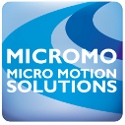 |
| December 02, 2014 | Volume 10 Issue 45 |
Motion Control News & Products
Designfax weekly eMagazine
Archives
Partners
Manufacturing Center
Product Spotlight
Modern Applications News
Metalworking Ideas For
Today's Job Shops
Tooling and Production
Strategies for large
metalworking plants
Robots think and act on the fly at moving assembly line speeds
 Inbolt and FANUC are launching a manufacturing breakthrough enabling FANUC robots to tackle one of the most complex automation challenges: performing production tasks on continuously moving parts at line speeds. With Inbolt's AI-powered 3D vision, manufacturers can now automate screw insertion, bolt rundown, glue application, and other high-precision tasks on parts moving down the line without costly infrastructure investments or cycle time compromises.
Inbolt and FANUC are launching a manufacturing breakthrough enabling FANUC robots to tackle one of the most complex automation challenges: performing production tasks on continuously moving parts at line speeds. With Inbolt's AI-powered 3D vision, manufacturers can now automate screw insertion, bolt rundown, glue application, and other high-precision tasks on parts moving down the line without costly infrastructure investments or cycle time compromises.
Learn more.
Best high-speed rotary bearing in THK history
 THK has developed its best-performing, high-speed rotary bearing ever: the High-Speed, Double-Row Angular Contact Ring BWH. This rotary bearing has balls aligned inside a cage between the inner and outer rings and is part of the THK Rotary Series, along with the cross-roller ring. The main features of this product are its ability to receive loads in all directions as well as its high rigidity and rotational accuracy, which are equal to that of cross-roller rings. By adopting a new structure to change the rolling elements from rollers to balls, this product achieves the greatest high-speed performance ever offered by THK.
THK has developed its best-performing, high-speed rotary bearing ever: the High-Speed, Double-Row Angular Contact Ring BWH. This rotary bearing has balls aligned inside a cage between the inner and outer rings and is part of the THK Rotary Series, along with the cross-roller ring. The main features of this product are its ability to receive loads in all directions as well as its high rigidity and rotational accuracy, which are equal to that of cross-roller rings. By adopting a new structure to change the rolling elements from rollers to balls, this product achieves the greatest high-speed performance ever offered by THK.
Learn more.
Elevating tables: Precise vertical positioning in tight spaces
 As semicon-ductors and optical components become smaller and more sophisticated, the TZ Series of precision elevating tables from IKO International provides exceptional vertical positioning accuracy in a compact size. This unit features a unique wedge mechanism guided in the vertical direction by a pair of IKO C-Lube Super MX linear motion rolling guides arranged in parallel to achieve highly precise positioning with exceptional rigidity. An optional linear encoder provides full closed loop control to achieve positioning accuracy as high as 0.005 mm, with repeatability of +/-0.001 mm.
As semicon-ductors and optical components become smaller and more sophisticated, the TZ Series of precision elevating tables from IKO International provides exceptional vertical positioning accuracy in a compact size. This unit features a unique wedge mechanism guided in the vertical direction by a pair of IKO C-Lube Super MX linear motion rolling guides arranged in parallel to achieve highly precise positioning with exceptional rigidity. An optional linear encoder provides full closed loop control to achieve positioning accuracy as high as 0.005 mm, with repeatability of +/-0.001 mm.
Learn more and get all the specs.
This cobot is all about safety around people
 The COBOTTA PRO from DENSO Robotics is a lightweight, high-speed collaborative robot designed for communication between workers and robots while maximizing productivity. It delivers a blend of productivity and safety for both simple tasks and multi-step processes like assembly and inspection work. The 6-axis unit operates at speeds up to 2,500 mm per sec when no workers are near and slows or stops when people approach. Two models available: PRO 900 (max payload 6 kg) and PRO 1300 (max payload 12 kg). Many more functions and features.
The COBOTTA PRO from DENSO Robotics is a lightweight, high-speed collaborative robot designed for communication between workers and robots while maximizing productivity. It delivers a blend of productivity and safety for both simple tasks and multi-step processes like assembly and inspection work. The 6-axis unit operates at speeds up to 2,500 mm per sec when no workers are near and slows or stops when people approach. Two models available: PRO 900 (max payload 6 kg) and PRO 1300 (max payload 12 kg). Many more functions and features.
Learn more.
Powerful, pull-type clapper solenoids handle myriad jobs
 New powerful, low-profile, pull-type clapper solenoids are available from Magnetic Sensor Systems (MSS). Applications include valve control, locks, starters, ventilators, clamping, sorting, appliances, tools, HVAC, brakes, clutches, switches, mixing, fire suppression systems, door controls, detent latches, and more. The S-16-264 Series of 17 Pull-Type Clapper Solenoids have ampere turns (windings) adjusted to meet the specific force and duty cycle requirements of your application. They provide up to 130 lb (578 N) of force.
New powerful, low-profile, pull-type clapper solenoids are available from Magnetic Sensor Systems (MSS). Applications include valve control, locks, starters, ventilators, clamping, sorting, appliances, tools, HVAC, brakes, clutches, switches, mixing, fire suppression systems, door controls, detent latches, and more. The S-16-264 Series of 17 Pull-Type Clapper Solenoids have ampere turns (windings) adjusted to meet the specific force and duty cycle requirements of your application. They provide up to 130 lb (578 N) of force.
Get all the specs for these solenoids and other options.
Tech Tip: Belt, screw, or chain-driven actuator?
 Bishop-Wisecarver provides a quick, very useful guide to help you evaluate the right drive strategy for your system: belt, screw, or chain-driven actuator. Each drive type has unique advantages and limitations, so evaluating all your options will help you find the most suitable actuator setup for your specific application needs.
Bishop-Wisecarver provides a quick, very useful guide to help you evaluate the right drive strategy for your system: belt, screw, or chain-driven actuator. Each drive type has unique advantages and limitations, so evaluating all your options will help you find the most suitable actuator setup for your specific application needs.
Read the Bishop-Wisecarver blog.
Ultra-precise linear stage -- down to 0.005 microns
 PI, a global leader in precision motion control and nanoposi-tioning, now offers fast delivery of the L-511 linear micropositioning stage, which is designed for applications requiring minimum incremental motion down to 20 nm, drive forces up to 22 lb, and multi-axis configuration options. The L-511 can be combined to form XY or XYZ motion systems and integrated with rotary stages. A variety of drive and encoder options (stepper and servo motors, rotary, and linear encoders) enable ultra-fine sensitivity. Applications include: metrology, laser processing, semiconductors, biotech, optical alignment, and advanced automation.
PI, a global leader in precision motion control and nanoposi-tioning, now offers fast delivery of the L-511 linear micropositioning stage, which is designed for applications requiring minimum incremental motion down to 20 nm, drive forces up to 22 lb, and multi-axis configuration options. The L-511 can be combined to form XY or XYZ motion systems and integrated with rotary stages. A variety of drive and encoder options (stepper and servo motors, rotary, and linear encoders) enable ultra-fine sensitivity. Applications include: metrology, laser processing, semiconductors, biotech, optical alignment, and advanced automation.
Learn more and get all the specs.
Choosing the right stepper motor: PM or hybrid?
 According to the experts at Lin Engineering, there are two primary types of stepper motors to consider: permanent magnet (PM) and hybrid. But which is right for your application? Both types have their advantages and disadvantages, and the choice ultimately depends on your specific requirements.
According to the experts at Lin Engineering, there are two primary types of stepper motors to consider: permanent magnet (PM) and hybrid. But which is right for your application? Both types have their advantages and disadvantages, and the choice ultimately depends on your specific requirements.
Read this informative Lin Engineering article.
New PTFE-free linear guide for precise positioning
 The new drylin WWP linear guide from igus features a PTFE-free locking carriage. Engineered from lubrication-free, high-performance polymers and aluminum, the guide offers a lightweight, hygienic, and low-maintenance alternative to complex mechanical and electronic adjustment systems. It is significantly more compact and lightweight than conventional recirculating ball-bearing systems. Applications include interior components in vehicles, aircraft, and furniture.
The new drylin WWP linear guide from igus features a PTFE-free locking carriage. Engineered from lubrication-free, high-performance polymers and aluminum, the guide offers a lightweight, hygienic, and low-maintenance alternative to complex mechanical and electronic adjustment systems. It is significantly more compact and lightweight than conventional recirculating ball-bearing systems. Applications include interior components in vehicles, aircraft, and furniture.
Learn more and get all the specs.
Heavy-duty gear units for mixing and agitating systems
 MAXXDRIVE industrial gear units from NORD DRIVE-SYSTEMS are an established drive solution for heavy-duty applications. In addition to conveying, lifting, and driving, they also play an important role in mixing and agitating systems. MAXXDRIVE units feature a compact, one-piece UNICASE housing that delivers long service life, easy maintenance, and quiet operation. Their robust design handles high axial and radial loads, achieves output torques up to 2,495,900 lb-in., and powers up to 8,075 hp.
MAXXDRIVE industrial gear units from NORD DRIVE-SYSTEMS are an established drive solution for heavy-duty applications. In addition to conveying, lifting, and driving, they also play an important role in mixing and agitating systems. MAXXDRIVE units feature a compact, one-piece UNICASE housing that delivers long service life, easy maintenance, and quiet operation. Their robust design handles high axial and radial loads, achieves output torques up to 2,495,900 lb-in., and powers up to 8,075 hp.
Learn more.
What are non-captive linear actuators?
 According to PBC Linear, their new non-captive linear actuators are different from the more common external versions of lead screw-driven linear actuators because they allow the lead screw to completely pass through the motor. This fundamental difference offers advantages for designs that have limited space available or for engineers looking to shrink the overall size of their design package.
According to PBC Linear, their new non-captive linear actuators are different from the more common external versions of lead screw-driven linear actuators because they allow the lead screw to completely pass through the motor. This fundamental difference offers advantages for designs that have limited space available or for engineers looking to shrink the overall size of their design package.
Read the full PBC Linear blog.
Güdel introduces Swiss-quality tracks for cobots
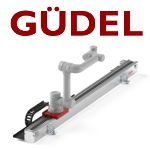 Güdel Inc. is highlighting new technologies at Automate 2025 booth #2418 that demonstrate its unmatched ability to solve automation engineering challenges. One is the Cobomover, a 7th-axis linear track purpose-built for collaborative and lightweight robots. Designed and manufactured in Switzerland, this unit extends the working range of robots up to 5 m, allowing them to operate multiple workstations and perform a variety of tasks without manual repositioning. Compatible with over 60 cobots and small traditional robots.
Güdel Inc. is highlighting new technologies at Automate 2025 booth #2418 that demonstrate its unmatched ability to solve automation engineering challenges. One is the Cobomover, a 7th-axis linear track purpose-built for collaborative and lightweight robots. Designed and manufactured in Switzerland, this unit extends the working range of robots up to 5 m, allowing them to operate multiple workstations and perform a variety of tasks without manual repositioning. Compatible with over 60 cobots and small traditional robots.
Learn more and get all the specs.
New open-center XYZ stage
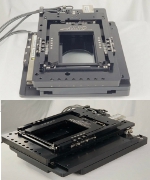 ThruSight-Focus is a high-performance, compact motion platform specifically engineered for applications requiring dual-side access to the sample or workpiece. It pairs ALIO's monolithic open-center XY stage -- known for its nanometer-level precision, crossed roller bearings, and direct linear drives -- with a novel Z-wedge mechanism that converts horizontal drive force into vertical motion via direct drive. This innovative architecture eliminates backlash, enhances servo responsiveness, and delivers fast, stable Z-axis movements -- all within a low-profile footprint.
ThruSight-Focus is a high-performance, compact motion platform specifically engineered for applications requiring dual-side access to the sample or workpiece. It pairs ALIO's monolithic open-center XY stage -- known for its nanometer-level precision, crossed roller bearings, and direct linear drives -- with a novel Z-wedge mechanism that converts horizontal drive force into vertical motion via direct drive. This innovative architecture eliminates backlash, enhances servo responsiveness, and delivers fast, stable Z-axis movements -- all within a low-profile footprint.
Learn more.
Eaton unveils differential engineered for EVs
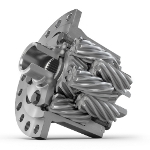 Intelligent power management company Eaton launched a new differential engineered specifically for electric vehicles at Auto Shanghai 2025 in China. The innovative design addresses the unique challenges presented by EV propulsion systems, including shared low-viscosity oil environments, increased sensitivity to noise, and the demands of high and instant torque delivery.
Intelligent power management company Eaton launched a new differential engineered specifically for electric vehicles at Auto Shanghai 2025 in China. The innovative design addresses the unique challenges presented by EV propulsion systems, including shared low-viscosity oil environments, increased sensitivity to noise, and the demands of high and instant torque delivery.
Read the full article.
Top Product: Integrated servo system is 20% smaller than standalone unit
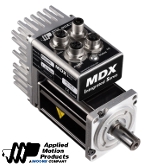 Applied Motion Products has introduced the MDX+ series, a family of low-voltage servo systems that integrate a servo drive, motor, and encoder into one package. This all-in-one drive is an ideal solution for manufacturers in logistics, AGV, medical, semiconductor, the solar industries, and many others.
Applied Motion Products has introduced the MDX+ series, a family of low-voltage servo systems that integrate a servo drive, motor, and encoder into one package. This all-in-one drive is an ideal solution for manufacturers in logistics, AGV, medical, semiconductor, the solar industries, and many others.
Read the full article.
New GE research center aims to take 3D printing to a whole new level
By GE Reports
On October 6, a Boeing 747 modified for testing jet engines taxied along a concrete runway on the edge of the Mojave Desert and took off with a brand new engine strapped to its left wing. Although the engine's maiden flight was short, it made aviation history.
For the first time, the engine, called LEAP, flew with 19 fuel nozzles 3D printed by a computer-guided laser from layers of metal powder. "We designed these nozzles to efficiently feed fuel into the jet engine, but they are also a work of art," says Greg Morris, a 3D-printing pioneer who leads additive manufacturing research at GE Aviation. (GE Aviation acquired his company, Morris Technologies, in 2012.) "Methods like 3D printing give designers new freedoms and unleash their imagination. You couldn't make this nozzle any other way."

A 3D-printed fuel nozzle for the LEAP jet engine. [Image credit: CFM International]
GE is aiming to have 3D printing and other additive manufacturing tools like it liberate every designer on its payroll. The company just announced it would spend $32 million to build a new research and education center focused on additive technologies in Pennsylvania. "We want to light the fire behind additive," Morris says. "This is still a young tool, but it's also a very powerful and disruptive tool. We want to maximize its use across all of GE's businesses."
Additive manufacturing is the opposite of traditional "subtractive" manufacturing methods like turning, milling, and drilling, which remove material from the product to achieve its final shape. Additive techniques, as the name implies, make parts by adding one thin layer of material on top of another. It's like building a loaf of bread from individual slices.
This approach allows designers to achieve lighter and more durable shapes that were previously impossible to produce. Since the finished components are very close to the final look, the technology can also dramatically reduce manufacturing waste.
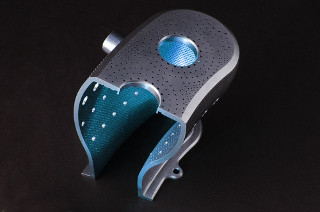
Additive manufacturing allows designers to create parts like this jet engine combustor that would be very difficult to make on conventional machines. [Image credit: GE Aviation]
The 3D-printed LEAP fuel nozzle, for example, is five times more durable than the previous model and 25 percent lighter. Additive manufacturing allowed engineers to reduce the number of individual pieces that were brazed and welded together from 20 to just one part, and achieve the best fuel flow geometry. "These tools unleash incredible creativity," Morris says.
(The nozzles are made by Advanced Atomization Technologies, a joint venture between GE and Parker Aerospace. The LEAP engine was developed by CFM International, a joint company owned equally by GE and France's Snecma.)
GE will use the new 125,000-sq-ft facility, which will be located in western Pennsylvania, to train designers and engineers on additive manufacturing design and production, and work closely with students at nearby Carnegie Mellon University, Penn State, and the University of Pittsburgh.
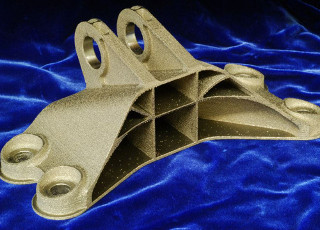
Last year, GE and GrabCAD held an open 3D-printing challenge to redesign a jet engine bracket. The original bracket weighed 2,033 g (4.48 lb), but the winner was able to reduce its weight by nearly 84 percent to just 327 g (0.72 lb).
The center will have 3D printers and other additive machines that can work both with plastics and metal. GE businesses will have access to the machines to handle overflow orders, make prototypes, and produce new parts without spending capital on their own. "The idea is to bring everyone together, share costs, and explore our common needs," Morris says. "It will also help us keep certain intellectual property in house."
Besides using additive manufacturing to make things, the center's 50 engineers will also work on developing new materials for additive technologies.
The new center will join five advanced manufacturing businesses that GE opened in the U.S. in the last two years: Greenville, SC (Power & Water), Asheville, NC (Aviation), Auburn, AL (Aviation), Jacksonville, FL (Oil & Gas), and Rutland, VT (Aviation).
Dan Heintzelman, GE vice chairman, said that a recent $75 million upgrade of the Rutland center has allowed GE Aviation to apply new advanced manufacturing technology to jet engine production and save $300 million.
"We made a big bet that additive manufacturing is not a flash in a pan," Morris says. "We know this is a way we are going to make various parts in the future. We are now in the process of training people and building awareness throughout the company. Engineers need to realize that they have this very powerful and enabling tool at their disposal." The new center is scheduled to open in 2015.
Read more GE Reports at www.gereports.com.
Published December 2014
Rate this article
View our terms of use and privacy policy
